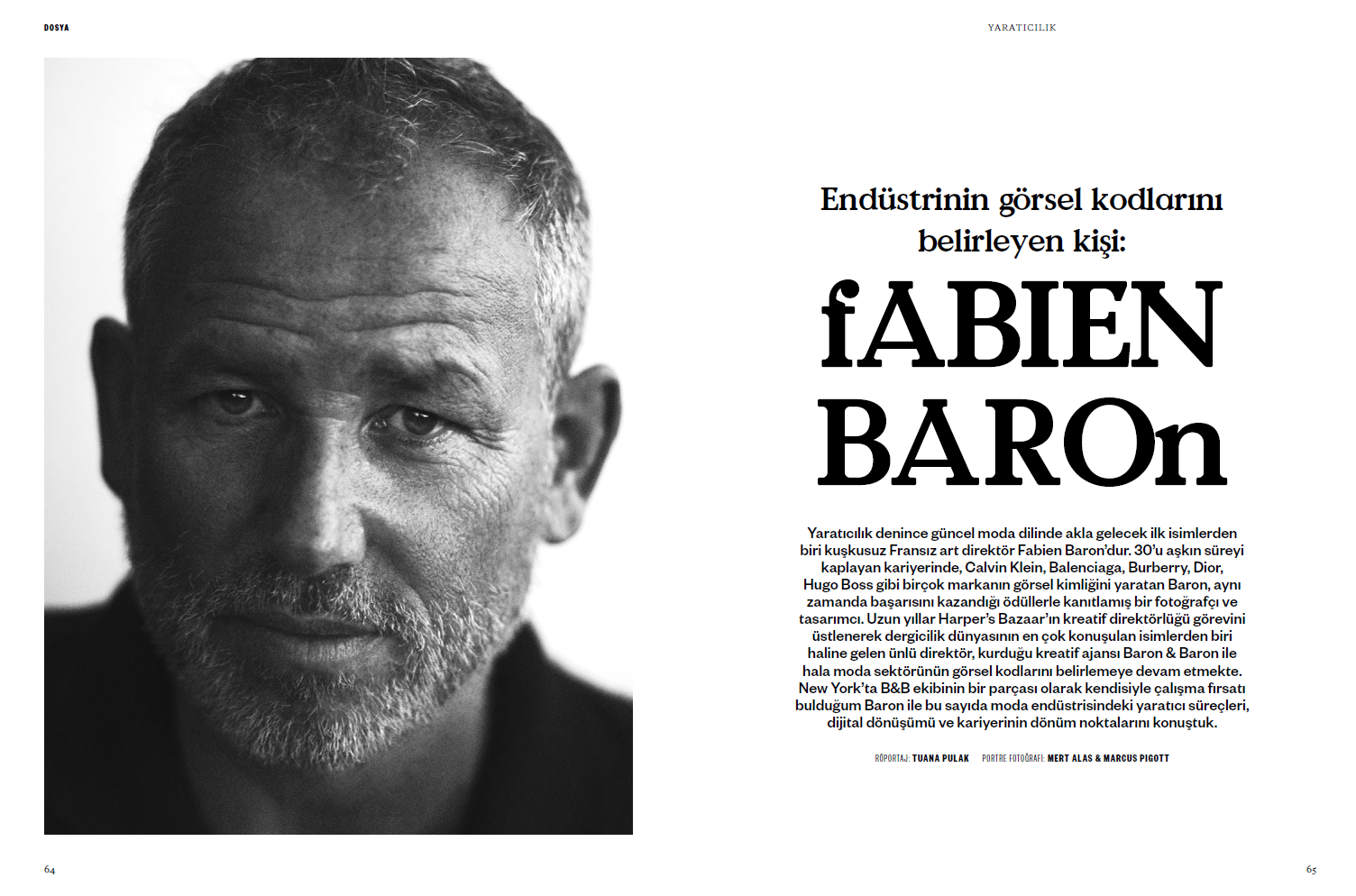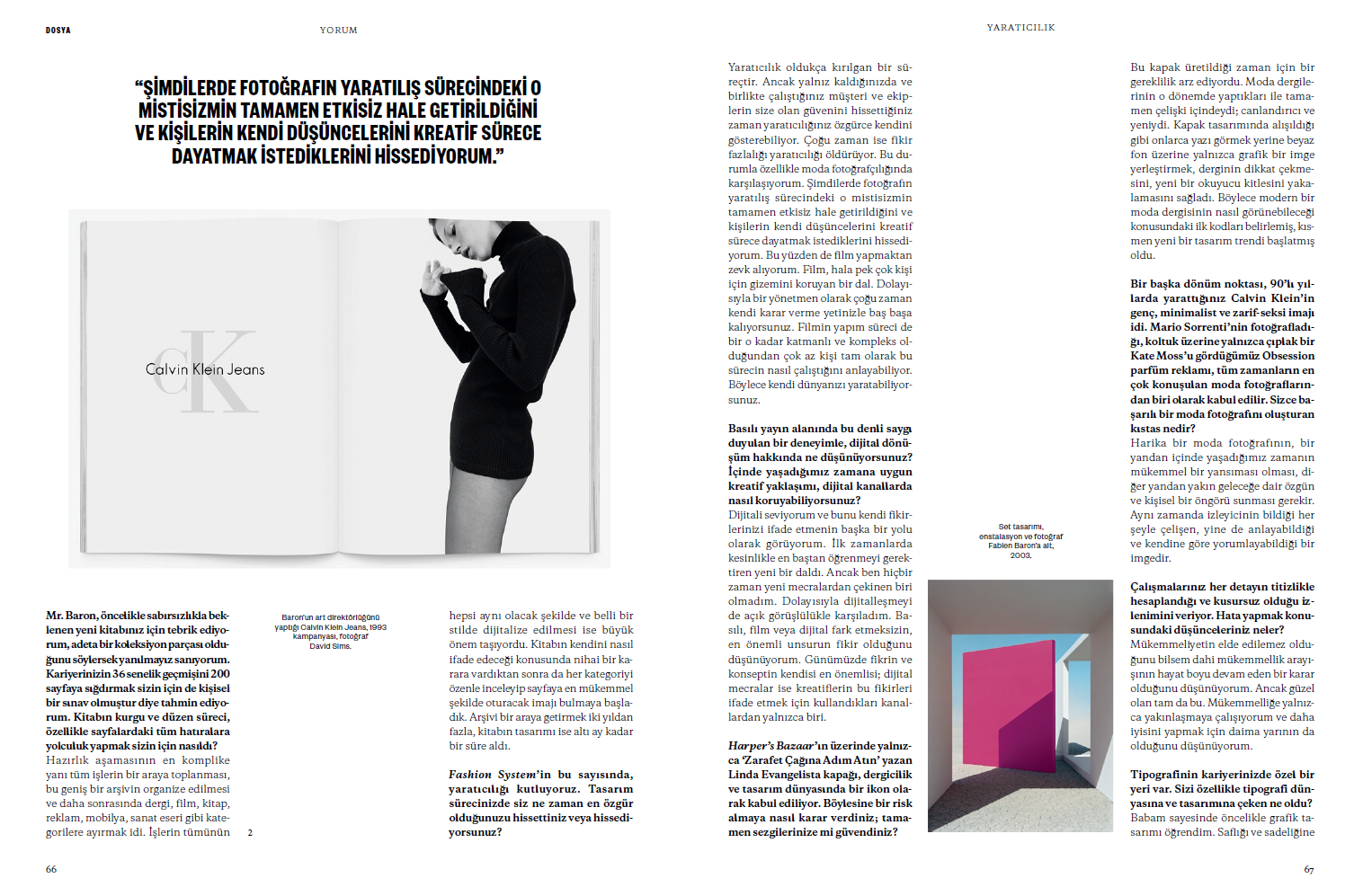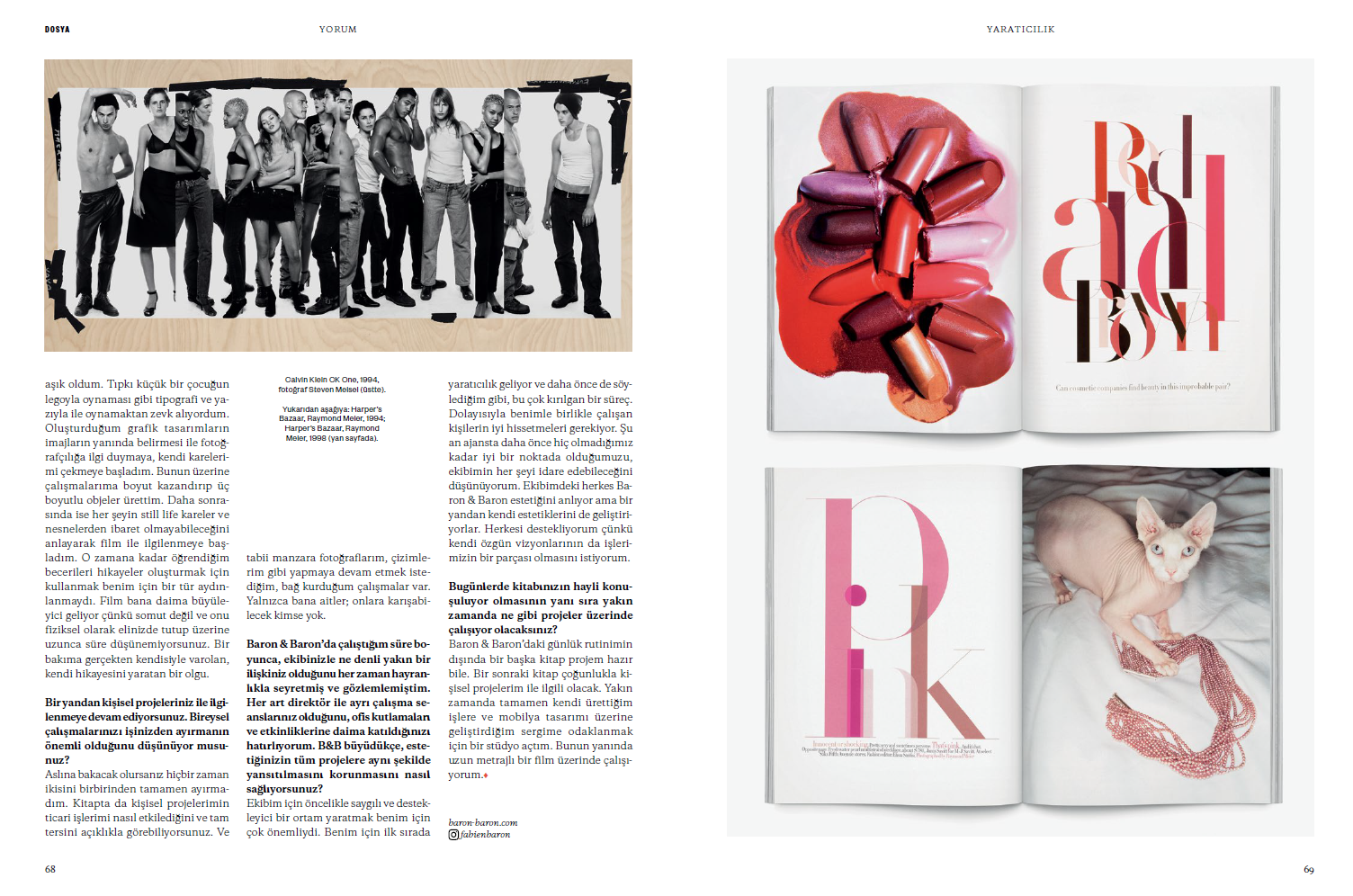Fashion System Magazine, Creativity Issue - January 2020
Fabien Baron



(interview printed in Turkish for publication)
Pulak: Mr. Baron, firstly congratulations on your much anticipated book - we wouldn’t be wrong in saying that it’s truly a collector’s item. It must have been a personal challenge for you as well to put 36 years of work into 200 pages. What was the editing process like, also to go through all the memories while doing so?
Baron: The most complicated task was collecting all of the work, organizing it into a massive archive and then separating it into folders from magazines, films, books, advertising, furniture, artwork etc. etc. To have all the work digitalized and each discipline with a very specific look was crucial, and once we had the concept down of how the book would articulate itself it was then about digging into each folder and finding the perfect image that would work best on that spread. It took more than two years to put the archive together, and about six months to design the book.
Pulak: For this issue, we’re celebrating the understanding of creativity. When do you feel or have felt the most free in your design / creative process?
Baron: Creativity is a very fragile process and it is when you are left alone and feel trusted by the clients and teams you are working with, that it can flow freely and flourish. Often too many opinions kill creativity. I see that a lot in fashion photography, where picture making has been totally demystified, and people feel entitled to their own opinions and want to impose them on the creative. That is why I enjoy film making. It is a craft that is still very mysterious for most people, so as a director you are most of the time left alone with your own decision making. Because the process of film making is also very multilayered and complex, very few people fully understand the way it works, so it allows you to be in your own bubble.
Pulak: With such a respected background in print, what are your thoughts on the digital? How does one maintain a relevant creative approach in digital mediums now?
Baron: I love digital, it is just another medium to express your own ideas. It certainly was another craft to learn at first, but I have never been afraid of new mediums, so I’ve welcomed digital with open arms. Ultimately, if it is print, film, or digital, what’s most important is the idea. The concept has become king again, and digital is yet another tool for creatives to develop such concepts.
Pulak: The Harper’s Bazaar cover of Linda Evangelista, with the text ‘Enter the Era of Elegance’ is considered an icon in magazine publishing and design. What was this kind of risk taking like, was it purely based on intuition?
Baron: That cover was a necessity at that time. It was a complete contradiction when you look at what the industry was producing at the time, so it was refreshing and new. Not to see tons of cover lines and opting for a very simple and graphic image on a white background made the magazine noticeable and relevant to a new audience. It drew a line in the sand for what a modern magazine could look like, and in some respect started a new trend.
Pulak: Another milestone, you’ve created the 90s youthful, minimalist, and elegantly sexy Calvin Klein image. The single Obsession ad by Mario Sorrenti with a nude Kate Moss on the couch is one of the most talked about fashion images of all time. In that respect, what do you think makes a great fashion image?
Baron: A great fashion image is on one hand a perfect reflection of the time we’re living in, and on the other hand, a projection into a near future of something very unique and personal, creating an image that contradicts what one knows, but that one can still understand and make their own.
Pulak: Your work gives out the impression that every detail is meticulously calculated and perfected. What are your thoughts on making mistakes?
Baron: The quest for perfection is a lifelong choice even though I know perfection is unattainable. But that’s what’s beautiful about it. I just try to get close. And there’s always tomorrow to do it better.
Pulak: The field of typography has a special place in your career. What drew you especially to the world of typography and its design?
Baron: The first thing I learned with my father was graphic design. I fell in love with it for its purity and its simplicity. I enjoyed playing with type just like a kid playing with blocks. With my graphics standing next to images all the time, I picked up on photography and started taking my own stills. Then, I added other dimensions to it all and started making still objects in three dimensions. Then I realized things did not have to be still images or objects anymore and I got into film making. It was a revelation for me, using all the skills I had learned along the way, to build narratives. There is something magical to me about film, I could not physically grab it and be contemplative about it. It really is its own thing, its own story.
Pulak: You also continue to practice your own personal projects on the side. Do you believe it’s important to separate personal work from the commercial at times? How so?
Baron: In a way I've never separated the two entirely, and it’s pretty clear in the book how some of my artwork has influenced some of my commercial work, and vice and versa. And, of course, there have been things I wanted to do and feel attached to, like the landscapes, the drawings etc... They are just me, no one else is involved.
Pulak: Throughout my time working at Baron & Baron, I’ve observed and have always been in awe of how close of a connection you had with your team. I remember you would have multiple work sessions with each art director, and always present at office get togethers. As B&B has grown in size and scale of work, how do you make sure that your eye and signature design aesthetic is reflected in all projects?
Baron: It was very important to me to create a very supportive and respectful environment for my team. I wanted creativity first, and like we said earlier, creativity is a very fragile process, so people have to feel good. I think we are now in the best place we’ve ever been at the agency and my team can handle anything. They understand the Baron & Baron aesthetic but they are also creating their own, and I encourage that in everybody as I want their vision to be part of the equation.
Pulak: Following the incredible buzz your book has generated at the moment, what other projects do you have lined up in the near future that you look forward to working on?
Baron: Apart for my daily routine at B&B, I am working on another book already. Mostly of my own artwork. I have also just opened my own studio where I am working solely on my artwork and a future show. I am also developing a feature movie.
Pulak: Thank you Mr. Baron
